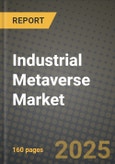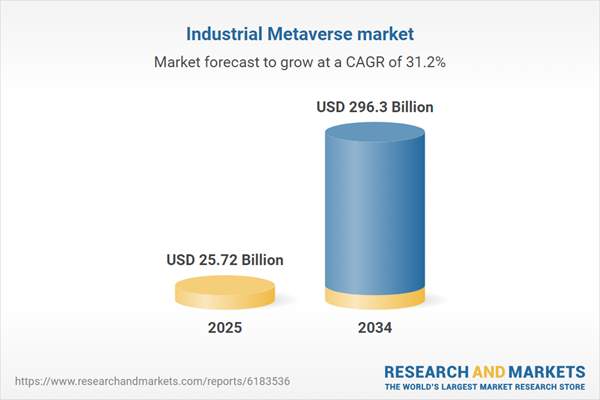Industrial Metaverse market
The industrial metaverse unifies real-time 3D, physics-based digital twins, IIoT telemetry, XR (AR/VR/MR), and AI into shared, persistent environments where engineering, operations, and supply-chain teams design, test, train, and run assets before and after they exist in the physical world. Core applications include model-based product development, virtual commissioning of production lines, layout and intralogistics simulation, connected work instructions and remote assistance, operator training and safety rehearsal, predictive maintenance, and energy optimization. Technically, stacks combine game-engine rendering with CAD/PLM connectors, simulation solvers, device orchestration, edge/cloud streaming, and secure integration to MES/ERP/SCADA via OPC UA/MQTT and REST APIs. Private 5G/Wi-Fi 6E, time-sync, and low-latency streaming bring multi-user collaboration to shop floors and construction sites; identity, access, and data governance protect sensitive IP across partners.Adoption is driven by compressed time-to-market, rising product and process complexity, labor shortages, and the need to de-risk CapEx and improve first-time-right quality. Sustainability targets elevate virtual prototyping, line right-sizing, and carbon-aware scheduling. Content creation is accelerating through CAD/BIM ingestion, procedure templates, and generative tools that synthesize scenes, synthetic data, and test cases. Challenges persist: model fidelity and upkeep, interoperability across vendors, cybersecurity, change management for frontline adoption, and clear ROI beyond pilots. The competitive landscape spans industrial software platforms, automation OEMs, device makers, hyperscalers, and systems integrators; differentiation hinges on open architectures, validated physics, low-touch content pipelines, and outcomes proven in production - cycle-time gains, quality yield, fewer incidents, faster ramp-ups, and measurable energy savings.
Industrial Metaverse market Key Insights
- From showcases to portfolios. Leaders standardize platforms, asset models, and authoring pipelines, then govern versions, roles, and content reuse so twins and training remain synchronized with PLM, ECNs, and SOPs.
- Closed-loop twins deliver value. Fusing telemetry with simulation enables what-if analysis, prescriptive setpoints, and virtual-to-real handoffs for start-ups, changeovers, and maintenance - reducing scrap and downtime.
- Interoperability beats walled gardens. Open formats, APIs, and connectors to PLM/MES/CMMS/GIS avoid data silos and accelerate multi-site replication; owners penalize black-box models they can’t audit.
- Edge rendering + private wireless. On-prem streaming and deterministic networks bring multi-user, low-latency collaboration to noisy, RF-challenged plants and yards while keeping sensitive data local.
- Device strategy is hybrid. MR headsets for on-line guidance, VR for training and design reviews, tablets/phones for quick access - chosen by task, hygiene, and PPE constraints to maximize utilization.
- AI accelerates content and decisions. Generative tools convert CAD/BOMs into scenes, procedures, and synthetic data; copilots summarize simulations, auto-tune parameters, and document MOC/validation.
- Virtual commissioning shortens ramp. Controls emulation, robot cell simulation, and safety zoning verification de-risk installs, cut travel, and compress time from FAT/SAT to volume production.
- Safety and compliance by design. Traceable models, e-signatures, and audit trails align with validation and EHS; immersive rehearsal improves lockout-tagout, confined space, and rescue readiness.
- Sustainability becomes measurable. Simulated energy, water, and material flows inform design and scheduling; telemetry closes the loop to verify kWh per unit, waste, and emissions reductions.
- Change management is decisive. Success correlates with frontline coaching, device hygiene/comfort, role-based UX, and KPI tracking tied to OEE, MTTR, and rework - not headset counts.
Industrial Metaverse market Reginal Analysis
North America
Enterprises prioritize design reviews, virtual commissioning, and immersive training tied to OEE, safety, and energy KPIs. Private 5G and edge streaming support multi-vendor cells and brownfield constraints. Procurement stresses cybersecurity, IP protection, and integration with PLM/MES/CMMS. Union engagement and validation frameworks speed frontline adoption. Outcome-based contracts and partner ecosystems drive scale across plant networks.Europe
Sustainability, safety, and data sovereignty shape platforms with open standards and on-prem options. Automotive, aerospace, pharmaceuticals, and process industries use metaverse workflows to validate lines, documentation, and regulatory evidence. Energy pricing accelerates simulation-led optimization of utilities and intralogistics. Strong apprenticeship traditions pair VR/MR with certified curricula; accessibility and multilingual support are baseline.Asia-Pacific
Greenfield capacity enables metaverse-native factories with standardized twins and digital work instructions. Electronics and battery lines rely on rapid reconfiguration and robot cell simulation; mega-sites stream XR over private wireless. Cost-sensitive buyers favor modular toolchains and local SI support. Government smart-manufacturing programs and industrial parks catalyze shared platforms and workforce upskilling.Middle East & Africa
New industrial cities, ports, and energy projects embed metaverse toolchains from inception - construction sequencing, safety rehearsal, and control-room twins. Harsh-environment ergonomics, sovereign hosting, and Arabic interfaces are priorities. Large EPCs and owners use virtual FAT/SAT and remote assistance to manage global supply chains and accelerate acceptance milestones.South & Central America
Mining, energy, food & beverage, and automotive hubs use immersive training and remote support to reduce incidents and travel across dispersed sites. Phased programs start with VR safety and virtual commissioning, then extend to operations twins. Connectivity variability elevates offline/edge modes and rugged devices; local integrators and managed services control TCO and speed adoption.Industrial Metaverse market Segmentation
By Component
- Software
- Hardware
- Services
By Technology
- AR
- VR
- MR
By Application
- Product Design & Development
- Virtual Prototyping
- Training & Simulation
- Remote Collaboration
- Maintenance & Repair
- Supply Chain Optimization
- Data Visualization & Analytics
By End-User
- Automotive
- Healthcare
- Logistics & Transportation
- Manufacturing
- Energy and utilities
- Others
Key Market players
NVIDIA, Microsoft, Siemens, Amazon Web Services (AWS), IBM, Meta, HTC, ABB, PTC, Dassault Systèmes, Bentley Systems, Unity, Intel, Schneider Electric, AVEVAIndustrial Metaverse Market Analytics
The report employs rigorous tools, including Porter’s Five Forces, value chain mapping, and scenario-based modelling, to assess supply-demand dynamics. Cross-sector influences from parent, derived, and substitute markets are evaluated to identify risks and opportunities. Trade and pricing analytics provide an up-to-date view of international flows, including leading exporters, importers, and regional price trends.Macroeconomic indicators, policy frameworks such as carbon pricing and energy security strategies, and evolving consumer behaviour are considered in forecasting scenarios. Recent deal flows, partnerships, and technology innovations are incorporated to assess their impact on future market performance.
Industrial Metaverse Market Competitive Intelligence
The competitive landscape is mapped through proprietary frameworks, profiling leading companies with details on business models, product portfolios, financial performance, and strategic initiatives. Key developments such as mergers & acquisitions, technology collaborations, investment inflows, and regional expansions are analyzed for their competitive impact. The report also identifies emerging players and innovative startups contributing to market disruption.Regional insights highlight the most promising investment destinations, regulatory landscapes, and evolving partnerships across energy and industrial corridors.
Countries Covered
- North America - Industrial Metaverse market data and outlook to 2034
- United States
- Canada
- Mexico
- Europe - Industrial Metaverse market data and outlook to 2034
- Germany
- United Kingdom
- France
- Italy
- Spain
- BeNeLux
- Russia
- Sweden
- Asia-Pacific - Industrial Metaverse market data and outlook to 2034
- China
- Japan
- India
- South Korea
- Australia
- Indonesia
- Malaysia
- Vietnam
- Middle East and Africa - Industrial Metaverse market data and outlook to 2034
- Saudi Arabia
- South Africa
- Iran
- UAE
- Egypt
- South and Central America - Industrial Metaverse market data and outlook to 2034
- Brazil
- Argentina
- Chile
- Peru
Research Methodology
This study combines primary inputs from industry experts across the Industrial Metaverse value chain with secondary data from associations, government publications, trade databases, and company disclosures. Proprietary modeling techniques, including data triangulation, statistical correlation, and scenario planning, are applied to deliver reliable market sizing and forecasting.Key Questions Addressed
- What is the current and forecast market size of the Industrial Metaverse industry at global, regional, and country levels?
- Which types, applications, and technologies present the highest growth potential?
- How are supply chains adapting to geopolitical and economic shocks?
- What role do policy frameworks, trade flows, and sustainability targets play in shaping demand?
- Who are the leading players, and how are their strategies evolving in the face of global uncertainty?
- Which regional “hotspots” and customer segments will outpace the market, and what go-to-market and partnership models best support entry and expansion?
- Where are the most investable opportunities - across technology roadmaps, sustainability-linked innovation, and M&A - and what is the best segment to invest over the next 3-5 years?
Your Key Takeaways from the Industrial Metaverse Market Report
- Global Industrial Metaverse market size and growth projections (CAGR), 2024-2034
- Impact of Russia-Ukraine, Israel-Palestine, and Hamas conflicts on Industrial Metaverse trade, costs, and supply chains
- Industrial Metaverse market size, share, and outlook across 5 regions and 27 countries, 2023-2034
- Industrial Metaverse market size, CAGR, and market share of key products, applications, and end-user verticals, 2023-2034
- Short- and long-term Industrial Metaverse market trends, drivers, restraints, and opportunities
- Porter’s Five Forces analysis, technological developments, and Industrial Metaverse supply chain analysis
- Industrial Metaverse trade analysis, Industrial Metaverse market price analysis, and Industrial Metaverse supply/demand dynamics
- Profiles of 5 leading companies - overview, key strategies, financials, and products
- Latest Industrial Metaverse market news and developments
Additional Support
With the purchase of this report, you will receive:- An updated PDF report and an MS Excel data workbook containing all market tables and figures for easy analysis.
- 7-day post-sale analyst support for clarifications and in-scope supplementary data, ensuring the deliverable aligns precisely with your requirements.
- Complimentary report update to incorporate the latest available data and the impact of recent market developments.
This product will be delivered within 1-3 business days.
Table of Contents
Companies Mentioned
- NVIDIA
- Microsoft
- Siemens
- Amazon Web Services (AWS)
- IBM
- Meta
- HTC
- ABB
- PTC
- Dassault Systèmes
- Bentley Systems
- Unity
- Intel
- Schneider Electric
- AVEVA
Table Information
| Report Attribute | Details |
|---|---|
| No. of Pages | 160 |
| Published | November 2025 |
| Forecast Period | 2025 - 2034 |
| Estimated Market Value ( USD | $ 25.72 Billion |
| Forecasted Market Value ( USD | $ 296.3 Billion |
| Compound Annual Growth Rate | 31.2% |
| Regions Covered | Global |
| No. of Companies Mentioned | 15 |









